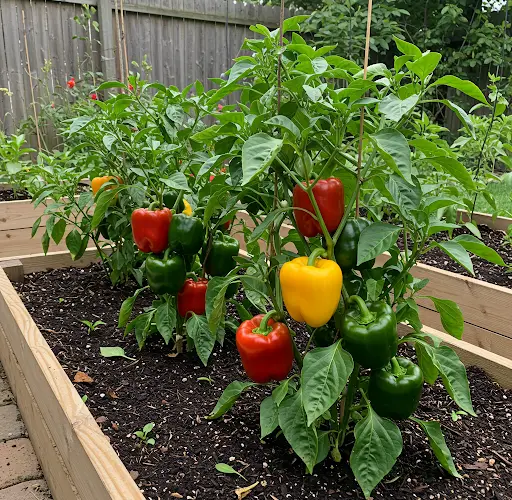How to Grow Bell Peppers at Home with Eggshell Tips for Maximum Yield
Growing bell peppers at home can be both fun and rewarding, especially when you see your plants loaded with bright, healthy fruits. Whether you’re gardening in containers, grow bags, or small plots, using natural and budget-friendly methods like eggshells can help boost your pepper plant’s health and productivity. Here’s a complete guide on how to grow bell peppers successfully at home, with a focus on using eggshells to enhance growth and fruit production.
Why Grow Bell Peppers at Home?
Bell peppers are not only tasty and versatile in the kitchen, but they’re also packed with nutrients like vitamins A, C, and potassium. Growing them at home allows you to enjoy pesticide-free vegetables, and you’ll get the satisfaction of harvesting your own food. Plus, bell pepper plants are relatively easy to care for with the right environment and techniques.
Ideal Conditions for Growing Bell Peppers
Bell peppers thrive in warm, sunny conditions. They require:
-
6–8 hours of direct sunlight daily.
-
Well-draining soil rich in organic matter.
-
Consistent watering, avoiding both drought and waterlogging.
-
Warm temperatures between 70–85°F (21–29°C) during the day.
You can grow them in pots, raised beds, or directly in the ground. Make sure the containers are at least 12 inches deep to accommodate their root systems.
Step-by-Step Guide to Growing Bell Peppers at Home
1. Choose the Right Seeds or Seedlings
Select high-quality seeds or healthy seedlings from a reliable source. If you start from seeds, sow them indoors 6–8 weeks before the last frost date. Transplant them outdoors when the soil is warm enough.
2. Prepare the Soil or Potting Mix
Use a loose, fertile potting mix enriched with compost or organic matter. If you’re planting in containers, make sure there is good drainage to prevent root rot.
3. Transplant Carefully
Once your seedlings are 4–6 inches tall and have at least two sets of true leaves, they’re ready to be transplanted. Space them 12–18 inches apart for optimal airflow and growth.
4. Use Eggshells to Boost Growth
Eggshells are an excellent, natural source of calcium carbonate—a nutrient essential for preventing blossom end rot, a common issue in peppers. Here’s how to use them:
-
Crushed Eggshells at Planting: Before transplanting, add a handful of crushed eggshells into the planting hole. This slowly releases calcium into the soil.
-
Eggshell Powder Fertilizer: Collect eggshells, dry them thoroughly, and grind them into a fine powder using a blender or mortar and pestle. Sprinkle this powder around the base of your plants every few weeks.
-
Eggshell Tea: Soak crushed eggshells in water overnight and use the liquid to water your pepper plants. This helps provide trace nutrients directly to the roots.
5. Water Wisely
Water deeply but infrequently to encourage strong root development. Let the soil dry slightly between watering. Overwatering can cause fungal diseases and root rot, while underwatering can stress the plant and reduce fruit yield.
6. Fertilize Regularly
In addition to eggshells, feed your plants with a balanced organic fertilizer every 2–3 weeks. Choose one that contains nitrogen, phosphorus, and potassium (NPK) in a balanced ratio, such as 5-5-5 or 10-10-10. Organic options like compost tea, fish emulsion, or seaweed extract are great choices.
7. Support the Plants
As your bell peppers grow and start producing fruits, they may need staking or cages to support the weight and prevent the stems from breaking.
8. Watch for Pests and Diseases
Common pests include aphids, whiteflies, and spider mites. You can control them by spraying with neem oil or soapy water. Keep an eye out for fungal diseases, especially in humid conditions, and remove any infected leaves promptly.
Harvesting Your Bell Peppers
Bell peppers are typically ready for harvest 60–90 days after transplanting. You can pick them when they’re green or wait for them to ripen to red, yellow, or orange, depending on the variety. Use scissors or garden shears to cut the fruit from the plant, leaving a small stem attached.
Regular harvesting encourages the plant to produce more fruit, so don’t let mature peppers stay on the plant too long.
Final Tips
-
Mulch around the base of your plants to retain moisture and suppress weeds.
-
Rotate crops each year if you’re planting in the ground to avoid soil-borne diseases.
-
Don’t over-fertilize with nitrogen—this encourages leaf growth but reduces flowering and fruiting.
By incorporating simple methods like using eggshells into your pepper-growing routine, you’ll naturally enhance soil health, prevent common problems, and enjoy a bountiful harvest of bell peppers right from your backyard or balcony.



